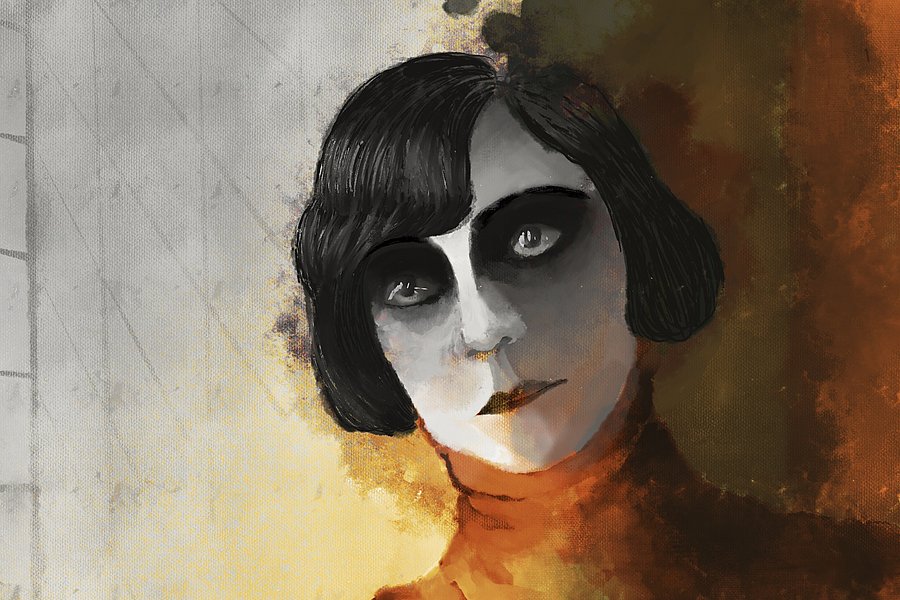
Hamlet as Woman
Prof. Dr. Sandra Heinen / English /American Studies
Photo: Berenika Oblonczyk
Progressive image of women in film
The Hamburg film premiere of Hamlet in 1921 showed actress Asta Nielsen in a male role for the first time
On January 27, 1921, the film version of Hamlet, based on the book The Mystery of Hamlet by the American Shakespeare scholar Edward P. Vining, starring the actress Asta Nielsen, premiered in Hamburg and became a worldwide success. Following Vining's thesis, Hamlet in the film is actually a woman. With her portrayal, Nielsen tackled one of the most important discussions of modern times, the gender debate. How did she succeed?
Heinen: The film extends Vining's eccentric thesis that the Dane prince is actually a woman through a plausibilizing prequel: In a prelude preceding the main action, we see the queen pretending her newborn daughter is the male heir to the throne because she believes the king is mortally wounded and wants to save the throne by lying. The reference to Vining in the film's opening credits primarily provides the filmmakers with the legitimation to deviate clearly from the highly cultural literary model in the still quite young and not yet fully established medium and thus to appropriate it self-consciously, because the deviations appear as 'scientifically vouched for' (even if Vining's thesis actually says more about the role expectations of the amateur researcher than about the Shakespearean drama).
The basic idea that Hamlet must pretend to be a man for reasons of state is not developed in the film into a critique of the social system that denies women the right to rule, which is close from today's perspective. However, it does bring into focus the performative nature of gender identities: unlike many earlier and later theatrical productions in which Hamlet was played by actresses, viewers of Asta Nielsen's Hamlet are not meant to forget that they are watching a woman playing a man. An added romantic plot line repeatedly recalls Hamlet's actual gender identity, as he(she) has fallen in love with Horatio and is shown several times struggling with his/her own 'feminine', and therefore non-role-conforming, feelings.
Although Hamlet's love sorrow indicates that he/she is a woman at heart (for whom nothing is as important as the beloved man), and the film here remains attached to the old role models, in other aspects the production invokes a clearly more modern image of women. For the slender body of Nielsen, clad in tights and tunic, her hair coiffed into a pageboy head, alludes not only to medieval knight costumes, but also to the progressive image of women just emerging at the time, the 'flappers', who confidently defied traditional role expectations and expressed their independence by wearing (relatively) short skirts and short hair. Some of the added scenes contribute to the embellishment of this variant of the 'New Woman' presented in the film, such as scenes showing Hamlet studying at university or in action at fencing school, activities traditionally reserved for men. Nielsen's fame and the resulting success of the film popularized the modern type of woman presented by the actress, which was probably the most tangible intervention in the contemporary gender debate.
One day after the Berlin premiere on February 5, 1921, the film critic Willy Haas, who belonged to the circle of Franz Kafka and Franz Werfel, tore the film apart, with the exception of Asta Nielsen's performance, about which he said in summary: "It would be ridiculous to speak of 'good moments' - where every second is masterful". What did Nielsen have that others were missing?
Heinen: Since Hamlet is a silent film, the actors' and actresses' bodies are their primary means of expression. And this was mastered by the leading actress. Her posture, gestures and facial expressions are of remarkable expressivity and nuance. For today's viewers, Nielsen's portrayal may seem theatrical or exaggerated due to changes in viewing habits, but in the context of the predominantly speechless form of expression in early film, she conveys the emotions of the main character with the necessary impressiveness.
Nielsen's acting is supported by costumes and makeup. Her dark clothing makes the main character stand out clearly in many shots, both from the respective background and from the other characters. Nielsen's face is made up in white, and is framed by the dark mop of hair for contrast. The actress' already large eyes, which are her most important means of expression, are further emphasized by darkly painted eye sockets. Cinematographic techniques are also used purposefully to set the scene for Asta Nielsen. Thus, repeated close-ups expose her face. Several times these are combined with circular apertures that once again narrow the visible area, making the actress' face the sole object of observation.

The subject of gender-swapping is also repeated again and again in later films: Victor/Victoria (1982), Yentl (1983), Boys Don't Cry (1999) or Albert Nobbs (2011). What attracts artists to this motif to this day?
Heinen: The aforementioned films belong to different genres and the respective act of cross-dressing is furthermore motivated by other circumstances on the level of the plot. Therefore, one should differentiate here: Victor/Victoria is a variant of the comedy of mistaken identity in which the protagonist's assumption of the male gender role is primarily the occasion for entertaining entanglements. Moreover, the assumption of roles is only temporary, i.e. the original gender identity and the traditional gender order - represented by the promising heterosexual couple relationship - are restored at the end and therefore not fundamentally questioned.
Albert Nobbs and Yentl are historical films whose plots are set in conservative societies of the late 19th and early 20th centuries, respectively in contexts where women's agency was severely limited. Accordingly, the decision of the respective female protagonists to pose as men is an act of self-empowerment and a liberation from the restrictions of the strongly patriarchal worlds in which they live. Accordingly, the feminist critique of patriarchal societies that thus takes place is not relativized in either film by a romantic happy ending or a return to the traditional gender order. However, due to the historical contextualization, the criticism is directed solely at the past; the present remains unaffected and appears as a better alternative.
Things are quite different with the film Boys Don't Cry, for two reasons: First, the plot takes place only a few years before the film's release and is also based on a true story. The social criticism articulated by the film therefore claims to be directly relevant to the present. On the other hand, the film is not about a woman who slips into the role of a man in order to achieve a goal that she can only achieve as a man, but about a person who feels like a man but was born with the body of a woman. For the protagonist Brendon Teena, the decision to pretend to be a man is therefore neither a costuming nor a rebellion against patriarchy, but rather the (in the film as in reality) ultimately cruelly punished attempt to live out his own gender identity.
The thematization of a change of gender identity can thus have very different functions, whereby in the aforementioned films the spectrum ranges from the generation of comedy and entertainment moments to criticism of overcome forms of discrimination (and thus at the same time an implicit representation of the present as an emancipated society) to criticism of currently still effective restrictive gender norms.
Uwe Blass (Interview from January 4, 2021)
Prof. Dr. Sandra Heinen works in the English/American Studies Department of the School of Humanities in the area of literature and media studies.
